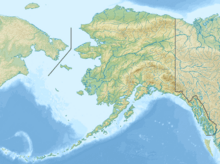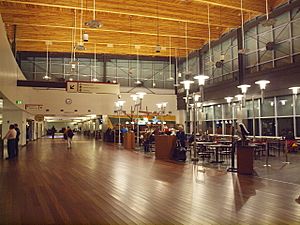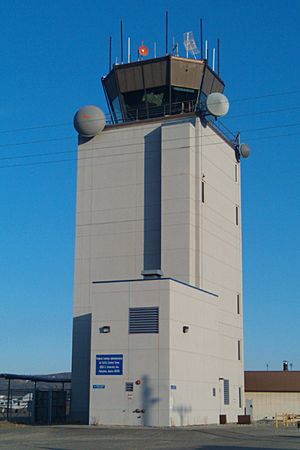Fairbanks International Airport facts for kids
Quick facts for kids
Fairbanks International Airport
|
|||||||||||||||||||||||
|---|---|---|---|---|---|---|---|---|---|---|---|---|---|---|---|---|---|---|---|---|---|---|---|
 |
|||||||||||||||||||||||
 |
|||||||||||||||||||||||
| Summary | |||||||||||||||||||||||
| Airport type | Public | ||||||||||||||||||||||
| Owner | State of Alaska DOT&PF | ||||||||||||||||||||||
| Serves | Fairbanks, Alaska | ||||||||||||||||||||||
| Hub for |
|
||||||||||||||||||||||
| Elevation AMSL | 439 ft / 134 m | ||||||||||||||||||||||
| Coordinates | 64°48′54″N 147°51′23″W / 64.81500°N 147.85639°W | ||||||||||||||||||||||
| Map | |||||||||||||||||||||||
| Runway | |||||||||||||||||||||||
|
|||||||||||||||||||||||
| Statistics | |||||||||||||||||||||||
|
|||||||||||||||||||||||
|
Source: Federal Aviation Administration
Source: Bureau of Transportation |
|||||||||||||||||||||||
Fairbanks International Airport (IATA: FAI, ICAO: PAFA, FAA LID: FAI) is a public airport in Fairbanks, Alaska. It's owned by the state of Alaska. The airport is located about three miles (5 km) southwest of downtown Fairbanks.
Fairbanks is the smallest city in the United States that has direct flights to Europe. For example, Condor offers weekly flights to Frankfurt, Germany, during the summer. Air North also flies internationally to Canada from Fairbanks.
Contents
History of Fairbanks Airport
Early Flights and Growth
Fairbanks International Airport opened in 1951. It took over all the regular airline flights that used to go to Ladd Army Airfield.
In the 1950s, Alaska Airlines used Fairbanks as its main hub. A hub is a central airport where an airline connects many flights. From Fairbanks, Alaska Airlines flew to cities like Seattle and Portland, and also to other places within Alaska, such as Anchorage and Nome.
By 1967, Alaska Airlines moved its main hub to Anchorage. However, flights between Anchorage and Fairbanks still happen today.
Pan American World Airways (Pan Am) also served Fairbanks starting in 1932. Pan Am wanted to use Fairbanks as a stop for flights to Asia. But this plan was delayed because of problems getting permission from the Soviet Union and then because of World War II. Pan Am finally started transpacific flights from New York and Seattle to Tokyo, stopping in Fairbanks, in September 1969.
Later, other airlines like Japan Airlines and Korean Air began using Fairbanks. They used it as a technical stop for their cargo flights across the Pacific Ocean in the late 1970s. A technical stop means an aircraft lands to refuel or for maintenance, but not to pick up or drop off passengers or cargo.
Modern Airport Development
On October 11, 2009, Fairbanks International Airport opened a brand new terminal building. The old terminal, built in 1948, was then taken down.
The new terminal was designed to meet modern security standards set by the Transportation Security Administration (TSA). It also has better architecture and more jet bridges. Jet bridges are the walkways that connect the terminal directly to the airplane, so you don't have to walk outside. The new terminal has six jet bridges, which is one more than the old building.
The new building uses special double low-e triple-glazed glass. This type of glass helps keep the building warm in winter and cool in summer, saving energy. Even though it's a modern building, its overall size is smaller than the old one.
In the 12 months leading up to February 28, 2018, the airport had nearly 120,000 aircraft operations. This means about 328 planes took off or landed each day. Most of these flights were for general aviation (private planes) or air taxi services. There were 569 aircraft based at the airport at that time.
Airport Facilities
Terminal Building
The main terminal building is on the southwest side of the airport. It has seven gates where passengers board and exit planes. Two gates are for smaller commuter planes, and five are for larger aircraft.
Runways for Aircraft
Fairbanks International Airport covers a large area of about 3,470 acres (1,404 hectares). It is located 439 feet (134 meters) above sea level.
The airport has four different runways:
- Runway 2L/20R: This is the longest runway, measuring 11,800 feet (3,597 meters) long and 150 feet (46 meters) wide. It has an asphalt surface.
- Runway 2R/20L: This runway is 6,501 feet (1,981 meters) long and 100 feet (30 meters) wide. It also has an asphalt surface.
- Runway 2/20: This shorter runway is 2,900 feet (884 meters) long and 75 feet (23 meters) wide. It has a gravel surface and can also be used as a ski strip for planes with skis instead of wheels.
- Runway 2W/20W: This runway is 5,400 feet (1,646 meters) long and 100 feet (30 meters) wide. It's a water runway in summer and a ski strip in winter, perfect for floatplanes or ski-equipped aircraft.
Airlines and Destinations
Passenger Flights
| Airlines | Destinations | Refs |
|---|---|---|
| 40-Mile Air | Delta, Healy Lake, Tok | |
| Air North | Seasonal Charter: Dawson City | |
| Alaska Airlines | Anchorage, Prudhoe Bay, Seattle/Tacoma | |
| American Airlines | Seasonal: Chicago–O'Hare (begins June 3, 2021), Dallas/Fort Worth (begins May 6, 2021) | |
| Condor | Seasonal: Frankfurt | |
| Delta Air Lines | Seattle/Tacoma Seasonal: Minneapolis/St. Paul |
|
| Everts Air | Anaktuvuk Pass, Arctic Village, Eagle, Fort Yukon, Galena, Huslia, Kaktovik, Kaltag, Nulato, Ruby, Venetie | |
| Ravn Alaska | Anchorage | |
| Sun Country Airlines | Seasonal: Minneapolis/St. Paul (begins May 29, 2021) | |
| United Airlines | Seasonal: Anchorage (begins May 6, 2021), Chicago–O'Hare, Denver (both resume May 6, 2021) | |
| Warbelow's Air Ventures | Beaver, Central, Circle, Manley Hot Springs, Minto, Rampart, Stevens Village | |
| Wright Air Service | Allakaket, Anaktuvuk Pass, Arctic Village, Bettles, Birch Creek, Chalkyitsik, Fort Yukon, Galena, Hughes, Huslia, Kaltag, Koyukuk, Lake Minchumina, Nulato, Ruby, Tanana, Venetie |
Cargo Flights
| Airlines | Destinations |
|---|---|
| DHL Aviation | Los Angeles |
| Empire Airlines | Anchorage |
Airport Statistics
| Carrier | Passengers (arriving and departing) |
|---|---|
| Alaska |
406,000(79.63%)
|
| Delta |
47,310(9.29%)
|
| Wright |
27,580(5.41%)
|
| Horizon |
13,120(2.57%)
|
| Peninsula |
4,790(0.94%)
|
| Other |
10,980(2.15%)
|
| Rank | City | Airport | Passengers | Carriers |
|---|---|---|---|---|
| 1 | Seattle–Tacoma International Airport | 129,350 | Alaska, Delta | |
| 2 | Ted Stevens Anchorage International Airport | 105,680 | Alaska | |
| 3 | Edward G. Pitka Sr. Airport | 3,450 | Everts, Wright | |
| 4 | Fort Yukon Airport | 2,820 | Everts, Wright | |
| 5 | Deadhorse Airport | 2,220 | Alaska | |
| 6 | Anaktuvuk Pass Airport | 1,990 | Everts, Wright | |
| 7 | Huslia Airport | 1,070 | Everts, Wright | |
| 8 | Ralph M. Calhoun Memorial Airport | 950 | Wright | |
| 9 | Allakaket Airport | 860 | Wright | |
| 10 | Ruby Airport | 790 | Everts, Wright |
Images for kids
See also
 In Spanish: Aeropuerto Internacional de Fairbanks para niños
In Spanish: Aeropuerto Internacional de Fairbanks para niños





